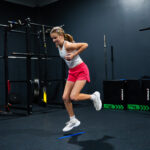The Best Youth Athlete Training Exercises
Choosing the right exercises is essential for effective youth athlete training. Young athletes benefit from workouts that improve strength, coordination, speed, and confidence—all without putting too much stress on developing bodies.
In this article, we’ll explore the best youth athlete training exercises that support growth, enhance performance, and prevent injury.
Why Exercise Selection Matters in Youth Athlete Training
Youth athletes are still growing, so their training must prioritize movement quality, not heavy weights or complex drills.
By focusing on foundational exercises, young athletes build the strength and stability they need to improve performance safely. These movements also help establish lifelong fitness habits.
Programs should include a variety of movements targeting different areas: strength, speed, mobility, and coordination.
Top Strength Exercises for Youth Athletes
Building strength doesn’t mean lifting heavy weights. Youth athlete training should focus on bodyweight and resistance-based exercises that improve control and form.
Here are five effective strength exercises:
-
Bodyweight Squats: Build lower body strength and reinforce balance.
-
Push-Ups: Strengthen chest, shoulders, and arms while improving posture.
-
Glute Bridges: Activate the posterior chain and support hip mobility.
-
Planks: Strengthen the core, which supports all athletic movements.
-
Wall Sits: Develop endurance and control in the quads and glutes.
These exercises teach young athletes to control their bodies—an essential skill before advancing to loaded movements.
Speed and Agility Drills for Young Athletes
Speed and agility are key components of youth athlete training. These drills help athletes react faster, change direction efficiently, and improve footwork.
Try including the following drills in your weekly routine:
-
High Knees: Boost running mechanics and coordination.
-
Ladder Drills: Improve foot speed and neuromuscular control.
-
Cone Shuffles: Enhance lateral quickness and balance.
-
Sprint Starts: Teach explosive acceleration and body positioning.
-
Hops and Bounds: Develop reactive strength and coordination.
Keep drills short and high-energy to maintain focus and fun. Rotate exercises regularly to keep training fresh and engaging.
Mobility and Flexibility Work
Youth athlete training isn’t complete without mobility. Flexibility prevents injury and supports better performance in every sport.
Incorporate these mobility exercises:
-
Arm Circles and Leg Swings: Warm up joints before activity.
-
Dynamic Lunges: Activate hip flexors and quads.
-
Cat-Cow Stretches: Improve spine mobility and posture.
-
World’s Greatest Stretch: A full-body movement for hips, hamstrings, and upper back.
Mobility work should be part of every training session, especially before speed or strength exercises.
Fun Conditioning for Endurance
Young athletes need cardiovascular fitness, but traditional long-distance running can be boring or overly stressful.
Use fun, game-based activities to improve conditioning:
-
Tag games: Improve agility and stamina in a fun way.
-
Relay races: Build teamwork and cardiovascular health.
-
Obstacle courses: Develop agility, strength, and endurance.
-
Short sprints with recovery: Mimic game conditions and develop power.
Keep sessions short and focused—quality beats quantity in youth athlete training.
How to Structure a Youth Athlete Training Session
A balanced session ensures development without overloading. Here’s a sample structure for a 60-minute training session:
-
Warm-Up (10 mins): Dynamic stretching and light movement
-
Movement Skills (15 mins): Speed or agility drills
-
Strength (15 mins): Bodyweight or resistance-based training
-
Conditioning (10 mins): Game or relay-style activity
-
Cooldown (10 mins): Static stretching and breathing
This format keeps sessions fun, efficient, and effective. For guided training, consider the programs at Next Level Athletics.
Safety Tips for Youth Training Exercises
Safety is always a top priority in youth athlete training. Follow these tips to ensure proper form and injury prevention:
-
Start with bodyweight before adding resistance.
-
Emphasize form over speed or reps.
-
Use proper surfaces (like turf or rubber flooring).
-
Give regular water breaks and plenty of rest.
-
Listen to feedback from athletes about how they feel.
According to the NSCA, resistance training is safe for youth when properly supervised and designed.
Conclusion: The Right Exercises Lead to Better Athletes
Youth athlete training should focus on the basics: strength, speed, coordination, mobility, and fun. The right mix of exercises helps athletes improve performance and avoid injury.
By sticking to foundational movements and age-appropriate drills, you give young athletes the best chance to succeed—on the field and beyond.
Training should be safe, fun, and consistent. With the right program, youth athletes will grow stronger, faster, and more confident every day.


Recent Comments